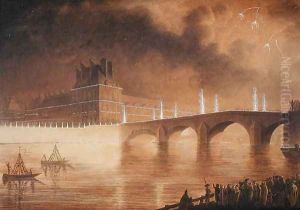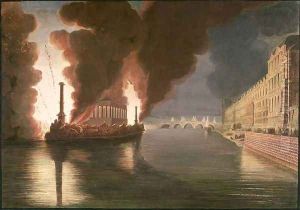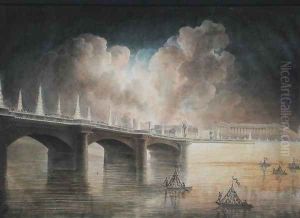Francesco Piranesi Paintings
Francesco Piranesi was an Italian engraver, etcher, architect, and archaeologist, best known for continuing the work of his father, Giovanni Battista Piranesi, a famous engraver and architect who was renowned for his etchings of Rome and of fictitious and atmospheric 'prisons' (Carceri d'Invenzione). Francesco was born in Rome in 1758, in the heart of the Papal States, into an environment rich in art, architecture, and history, which would have a profound influence on his career and style.
Following in his father's footsteps, Francesco learned the art of engraving and became his father's collaborator. After his father's death in 1778, he took over his workshop and publishing house. Francesco was responsible for printing the later editions of his father's works, which by then had become well known throughout Europe and were in high demand by collectors and patrons who were drawn to the grandeur and ruin of classical antiquity as well as the emerging neoclassical style.
Francesco Piranesi continued to produce engravings that were in the spirit of his father's work, but he also developed his own artistic identity. He worked on archaeological studies and took an active role in the excavation of various Roman sites, which further informed his engravings. His works often depicted ancient Roman architecture and artifacts, and he was particularly interested in the technical aspects of ancient Roman engineering.
In addition to his archaeological endeavors, Francesco also ventured into architectural design, although his contributions in this field are not as well-documented or celebrated as his engravings. It is known that he spent some time in Paris, where he was involved in the publication of a series of engravings based on ancient Greek and Roman art that influenced the French neoclassical movement.
Francesco's legacy, much like that of his father's, is tied to the dissemination of classical imagery and the romantic depiction of ruins, which helped to shape European ideas of archaeology and heritage in the late 18th and early 19th centuries. His works are considered important resources for understanding the knowledge and interpretation of classical antiquity during his time.
Unfortunately, Francesco Piranesi's career was cut short by his untimely death in 1810. His passing marked the end of a significant era in the history of engraving and the portrayal of classical antiquity. Despite his relatively short life, his contribution to the arts remained influential, especially in how the neoclassical style was expressed in printmaking and the understanding of ancient Roman culture.


